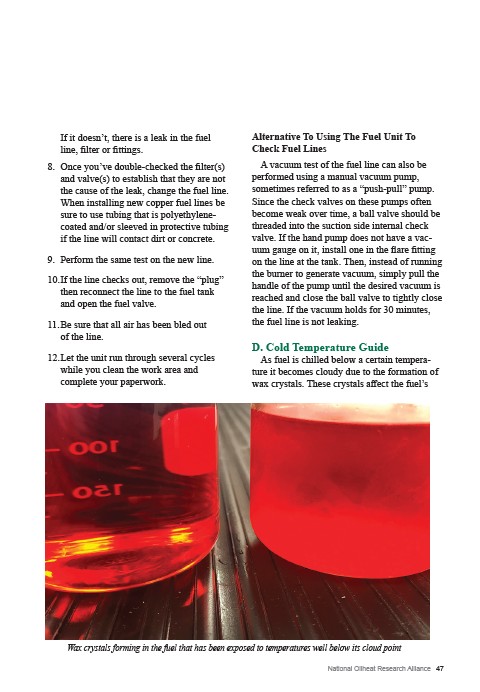
National Oilheat Research Alliance 47
If it doesn’t, there is a leak in the fuel
line, filter or fittings.
8. Once you’ve double-checked the filter(s)
and valve(s) to establish that they are not
the cause of the leak, change the fuel line.
When installing new copper fuel lines be
sure to use tubing that is polyethylenecoated
and/or sleeved in protective tubing
if the line will contact dirt or concrete.
9. Perform the same test on the new line.
10. If the line checks out, remove the “plug”
then reconnect the line to the fuel tank
and open the fuel valve.
11. Be sure that all air has been bled out
of the line.
12. Let the unit run through several cycles
while you clean the work area and
complete your paperwork.
Alternative To Using The Fuel Unit To
Check Fuel Lines
A vacuum test of the fuel line can also be
performed using a manual vacuum pump,
sometimes referred to as a “push-pull” pump.
Since the check valves on these pumps often
become weak over time, a ball valve should be
threaded into the suction side internal check
valve. If the hand pump does not have a vacuum
gauge on it, install one in the flare fitting
on the line at the tank. Then, instead of running
the burner to generate vacuum, simply pull the
handle of the pump until the desired vacuum is
reached and close the ball valve to tightly close
the line. If the vacuum holds for 30 minutes,
the fuel line is not leaking.
D. Cold Temperature Guide
As fuel is chilled below a certain temperature
it becomes cloudy due to the formation of
wax crystals. These crystals affect the fuel’s
Wax crystals forming in the fuel that has been exposed to temperatures well below its cloud point